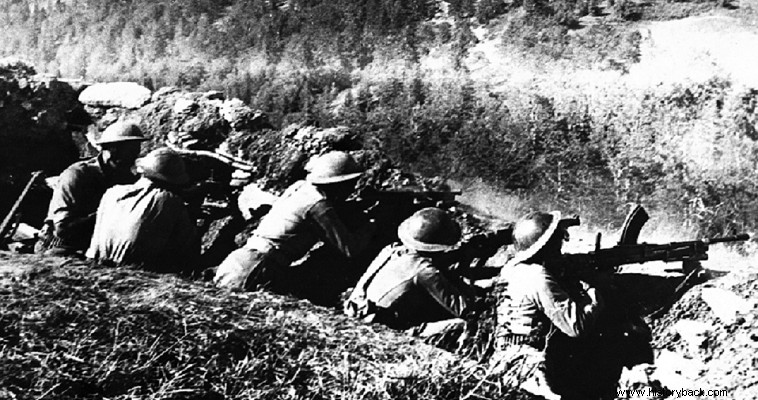
Skra has been known since the First World War. It is a small village in the prefecture of Kilkis built at an altitude of 520 m in Paiko, at a distance of about 4 km from the state of Skopje. On the evening of November 12, 1946, two platoons of the 1st Company of the 564th Infantry Battalion (TP) were stationed in the village.
Their total strength was 55 men. The company's third platoon manned the 85th border post. In the village was the commander of the company, captain Georgios Taboularis , but also the commander of the battalion major Konstantinos Pastras . In terms of armament the company had seven Bren machine guns, 10 sub-machine guns, two 2in howitzers, two PIAT anti-tank launchers and the men's individual armament. There were also four gendarmes in the village.
The officers and 6-8 soldiers lived in a building that was also used as an ammunition depot. The other men lived in three other buildings. The gendarmes manned the local station. There were five objective positions and an equal number of machine guns and a tentative support point at a very short distance from the village. A link between the posts was a mobile patrol.
The attack
At 04:00 on the morning of November 13, a force of 300 communist insurgents made a surprise attack against the company with the support of fellow villagers. An equal number of rebels blocked the roads to the village to prevent the arrival of reinforcements.
The rebels came from the groups of Paikos reinforced by a significant force of NOFites (Slavo-Macedonians). Also in these complexes there were also 25 officers trained in Bulkes. The Vermio group and possibly the Kaimaktsalan group also participated in the operation.
The insurgents had quietly approached the village under the cover of night from several directions managing to infiltrate the village. The rebels, apparently informed about this, headed towards the building where the officers were staying. Then, having surrounded the village, they opened fire with mortars, anti-tank launchers, machine guns, submachine guns and small arms.
Three garrison machine gun emplacements were almost immediately neutralized. In the meantime the soldiers began to fight as – as from the buildings where they were staying. The officers tried to deploy the soldiers in the prescribed positions, but leaving the building where they were staying, all were killed except for Captain Taboularis and a second lieutenant.
The head of the half-breeds, reserve lieutenant Moutsios, surrendered without a fight, leading his soldiers to do the same. Nevertheless the other soldiers and gendarmes continued to fight for 9 hours! At around 13.00 however, with the ammunition running out, Captain Taboularis ordered his men to break the cordon and attempt to reach outpost 85 where the 3rd Platoon was.
He himself, with a Bren in hand, along with two soldiers and two gendarmes, covered the movement of his men. After several soldiers escaped, he and the other four men fled. But then Tavoularis was injured and moments later received another blow and was killed. In the end, only second lieutenant Kouris, who was also wounded, together with about 20 men managed to be rescued.
After the "victory" the rebels entered the village and looted it, setting fire to houses and killing, according to the Army, 50 civilians. Among the dead was the heroic village teacher Vassiliki Papathanasiou, who was brutally tortured, but died shouting "Long live Greece".
In the afternoon of November 14, the rebels left with their loot towards the Yugoslav border. Many insurgents spoke in addition to Macedonian, Serbian and Bulgarian, and some wore Yugoslav army uniforms.
